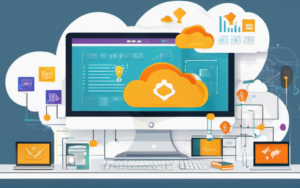Cloud computing has revolutionized the way we work, learn, and even play. From storing our photos online to running complex business applications, the cloud has become an integral part of our digital lives. But like any technology, cloud computing has its fair share of advantages and disadvantages. This post will explore the good, the bad, and the hilarious aspects of cloud computing, helping you understand its potential and its limitations.
Cloud Computing: A Modern Marvel
What is Cloud Computing?
In essence, cloud computing involves delivering computing services – servers, storage, databases, networking, software, analytics, and intelligence – over the internet. Instead of owning and maintaining physical infrastructure, you access these resources on demand from a cloud provider like Amazon Web Services (AWS), Microsoft Azure, or Google Cloud Platform (GCP). Think of it as renting computing power instead of buying it.
Types of Cloud Services
There are three main types of cloud services:
- Infrastructure as a Service (IaaS): This provides access to basic computing resources like servers, storage, and networking. You have more control over the infrastructure but also more responsibility for managing it.
- Platform as a Service (PaaS): This offers a platform for developing and deploying applications without managing the underlying infrastructure. It simplifies development and deployment, but you have less control over the environment.
- Software as a Service (SaaS): This provides ready-to-use applications accessed over the internet. You don’t need to install or manage anything; you simply subscribe and use the software.
Benefits of Cloud Computing
Cloud computing offers numerous advantages for businesses and individuals alike:
- Scalability: Easily scale your resources up or down based on your needs, saving you from overspending on unused resources.
- Cost-Effectiveness: Pay only for what you use, avoiding upfront investments in hardware and software.
- Accessibility: Access your data and applications from anywhere with an internet connection.
- Flexibility: Choose from a wide range of services and customize your cloud environment according to your requirements.
The Not-So-Sunny Side of the Cloud
While cloud computing offers many benefits, it’s not without its drawbacks:
Security Concerns
One of the biggest concerns with cloud computing is data security. Your data is stored on servers managed by a third party, raising questions about its vulnerability to breaches and unauthorized access. Cloud providers have robust security measures in place, but it’s essential to choose a provider with a strong track record and to implement your own security protocols.
Vendor Lock-in
Moving your data and applications to the cloud can create dependency on a specific vendor. Switching providers can be complex and costly, making it difficult to explore other options. This vendor lock-in can limit your flexibility and bargaining power.
Downtime and Reliability
Cloud services are not immune to outages. Server failures, network issues, or other unforeseen events can disrupt your access to data and applications. While cloud providers strive for high uptime and reliability, downtime can occur, potentially impacting your business operations.
Cloud Computing: A Comedy of Errors
Cloud computing is often portrayed as a seamless, magical experience. However, reality can be quite different, leading to some amusing anecdotes:
The “Cloud” is Just a Server Farm
The term “cloud” often evokes images of fluffy, ethereal entities. However, in reality, the cloud is simply a collection of servers housed in data centers. This realization can be a bit of a letdown for some, especially those who imagined a more mystical concept.
The “Cloud” is Not Always Cheap
While cloud computing can save costs compared to traditional infrastructure, it’s not always the most economical option. If you have a small, stable workload, you might find that owning your own hardware is more cost-effective. Additionally, unexpected usage spikes or complex application deployments can lead to higher-than-expected cloud bills.
The “Cloud” Can Be a Black Box
Cloud services can be complex, leaving users struggling to understand how things work behind the scenes. This lack of transparency can be frustrating, especially when trying to troubleshoot issues or optimize performance.
Conclusion: Embracing the Cloud with a Grain of Salt
Cloud computing has transformed the way we interact with technology. It offers numerous benefits, such as scalability, cost-effectiveness, and accessibility. However, it’s crucial to be aware of the potential drawbacks, including security concerns, vendor lock-in, and downtime. By carefully weighing the pros and cons, choosing the right cloud provider, and understanding the limitations of the cloud, you can harness its power while mitigating potential risks. As cloud technology continues to evolve, we can expect even more innovative solutions and exciting developments in the years to come.




